Search Result
Results for "
Anti-Fibrotic
" in MedChemExpress (MCE) Product Catalog:
6
Isotope-Labeled Compounds
| Cat. No. |
Product Name |
Target |
Research Areas |
Chemical Structure |
-
- HY-15307
-
|
KD025; SLx-2119
|
ROCK
|
Inflammation/Immunology
Cancer
|
|
Belumosudil (KD025) is a selective inhibitor of ROCK2 with IC50s of 105 nM and 24 µM for ROCK2 and ROCK1, respectively. Anti-fibrotic properties .
|
-
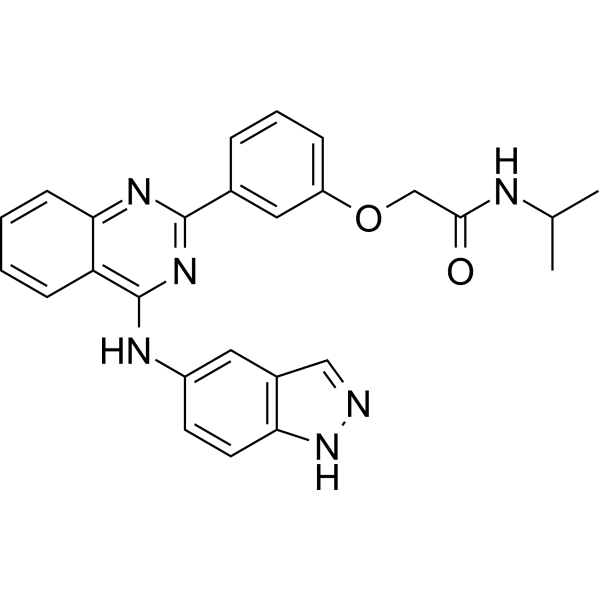
-
- HY-15307A
-
|
KD025 mesylate; SLx-2119 mesylate
|
ROCK
|
Inflammation/Immunology
|
|
Belumosudil mesylate (KD025 mesylate) is a selective inhibitor of ROCK2 with IC50s of 105 nM and 24 µM for ROCK2 and ROCK1, respectively. Anti-fibrotic properties .
|
-
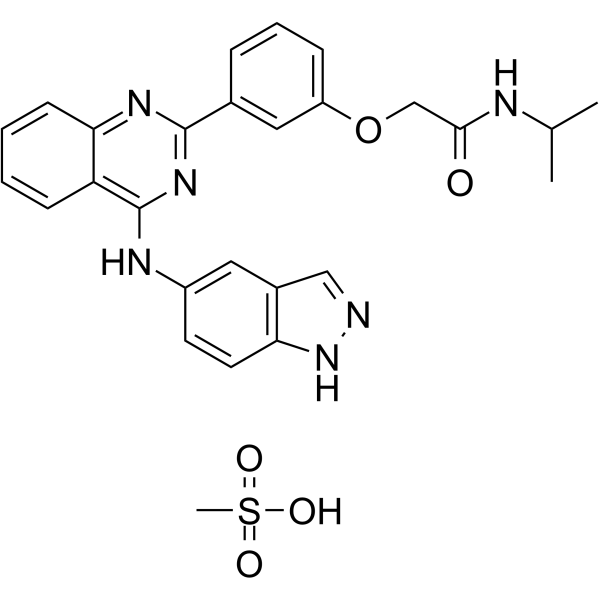
-
- HY-148087
-
|
|
RXFP Receptor
|
Cardiovascular Disease
|
|
AZD5462 is a RXFP1 modulator, can be used for heart failure research. RXFP1 is the cognate receptor for human relaxin, belongs to GPCR family 1c number with anti-fibrotic and anti-inflammatory properties .
|
-
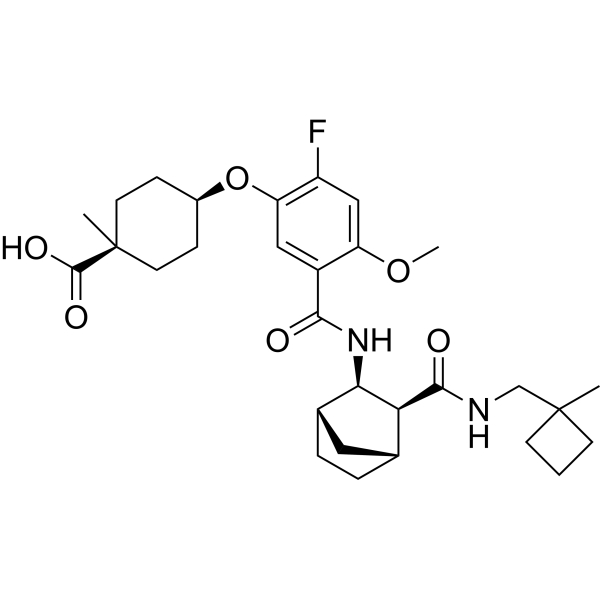
-
- HY-136657
-
SC-43
2 Publications Verification
|
Phosphatase
STAT
Apoptosis
|
Cancer
|
|
SC-43, a Sorafenib derivative, is a potent and orally active SHP-1 (PTPN6) agonist. SC-43 inhibits the phosphorylation of STAT3 and induces cell apoptosis. SC-43 has anti-fibrotic and anticancer effects .
|
-
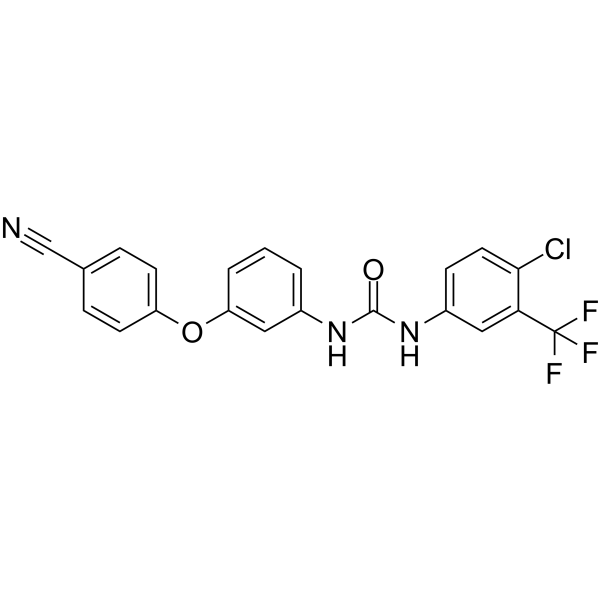
-
- HY-A0060
-
|
NKK 105
|
Lipoxygenase
|
Cancer
|
|
Malotilate (NKK 105), an orally active hepatotropic agent and an anti-fibrotic substance, selectively inhibits the 5-lipoxygenase (5-LOX) (IC50=4.7 μM). Malotilate prevents the development of hepatocytic injury in alcohol-pyrazole hepatitis by decreasing hepatic acetaldehyde levels and preventing the retention of transferrin in the hepatocytes .
|
-

-
- HY-P3618
-
|
|
Somatostatin Receptor
|
Neurological Disease
|
|
Cortistatin 29 is a neuropeptide. Cortistatin 29 alleviates neuropathic pain. Cortistatin 29 binds with high affinity all somatostatin (SS) receptor subtypes and shows IC50 values of 2.8, 7.1, 0.2, 3.0, 13.7 nM for SSTR1, SSTR2, SSTR3, SSTR4, SSTR5, respectively. Cortistatin 29 shows anti-fibrotic effects .
|
-
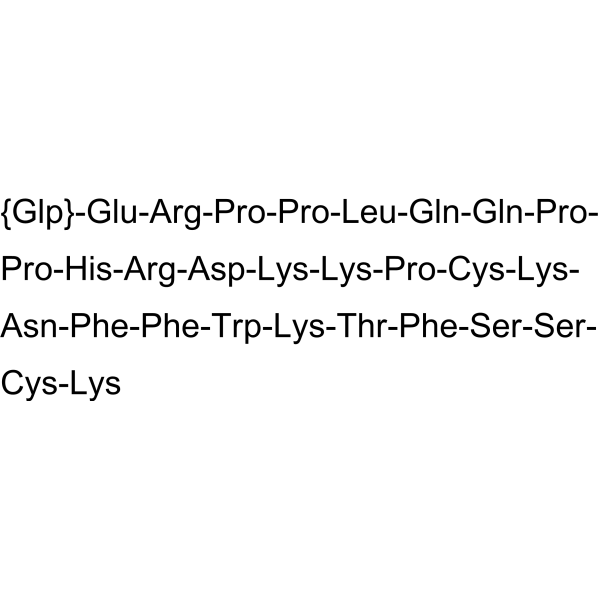
-
- HY-N6928
-
|
|
Others
|
Metabolic Disease
Cancer
|
|
Mogroside III-E is a cucurbitane-type compound isolated from Siraitia grosvenorii, inhibits NO release, with anti-fibrotic activity .
|
-
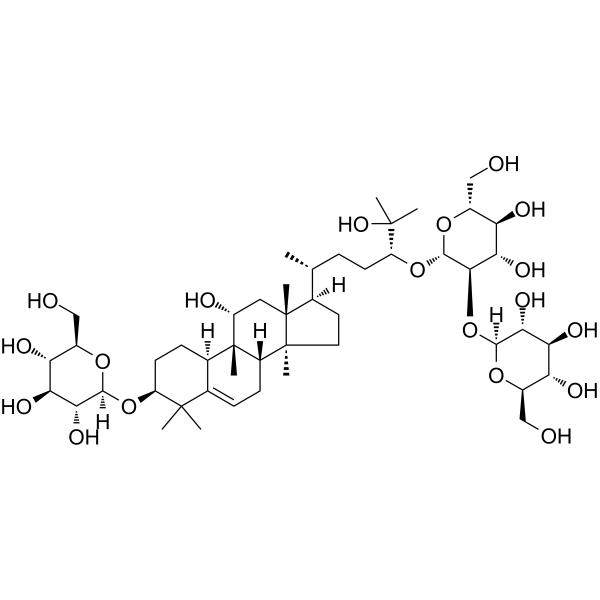
-
- HY-N0664
-
|
|
Bacterial
|
Infection
Neurological Disease
Inflammation/Immunology
Cancer
|
|
Aucubin, an iridoid glucoside, is isolated from Plantago asiatica, Eucommia ulmoides, the leaves of Aucuba japonica and more recently from butterfly larva. Aucubin has many biological activities, such as antioxidant, anti-aging, anti-inflammatory, antimicrobial, anti-fibrotic, anti-cancer, hepatoprotective, neuroprotective and osteoprotective effects .
|
-
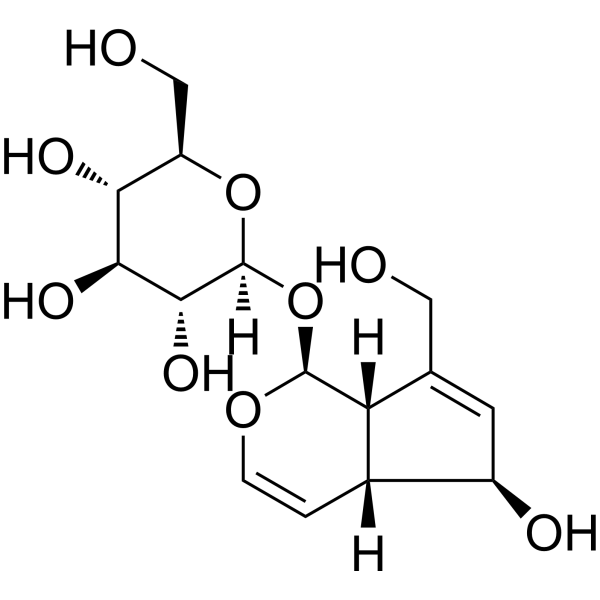
-
- HY-101737
-
|
Norucholic acid; nor-UDCA
|
Others
|
Inflammation/Immunology
|
|
24-norursodeoxycholic acid (Norucholic acid) is a side chain-shortened C23 homologue of UDCA and has shown potent anti-cholestatic, anti-inflammatory and anti-fibrotic properties.
|
-
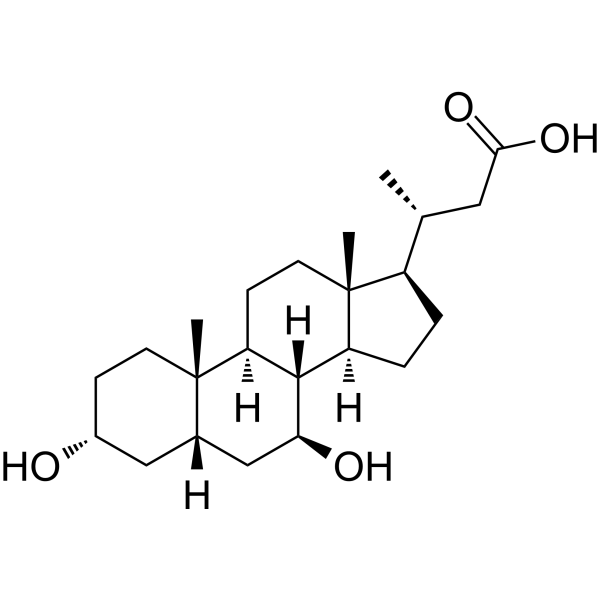
-
- HY-124646
-
|
|
IRE1
|
Inflammation/Immunology
|
|
KIRA-7, an imidazopyrazine compound, binds the IRE1α kinase (IC50 of 110 nM) to allosterically inhibit its RNase activity. KIRA-7 has an anti-fibrotic effect .
|
-
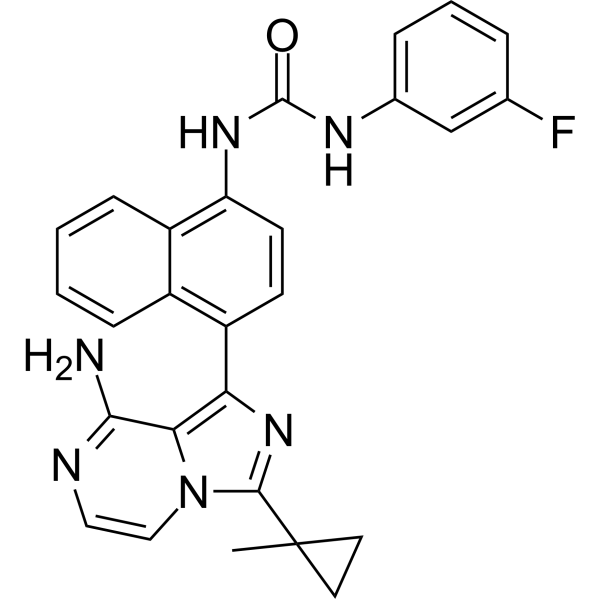
-
- HY-P0256
-
Apamin
3 Publications Verification
Apamine
|
Potassium Channel
|
Neurological Disease
Inflammation/Immunology
|
|
Apamin (Apamine) is an 18 amino acid peptide neurotoxin found in apitoxin (bee venom), is known as a specifically selective blocker of Ca 2+-activated K + (SK) channels and exhibits anti-inflammatory and anti-fibrotic activity .
|
-
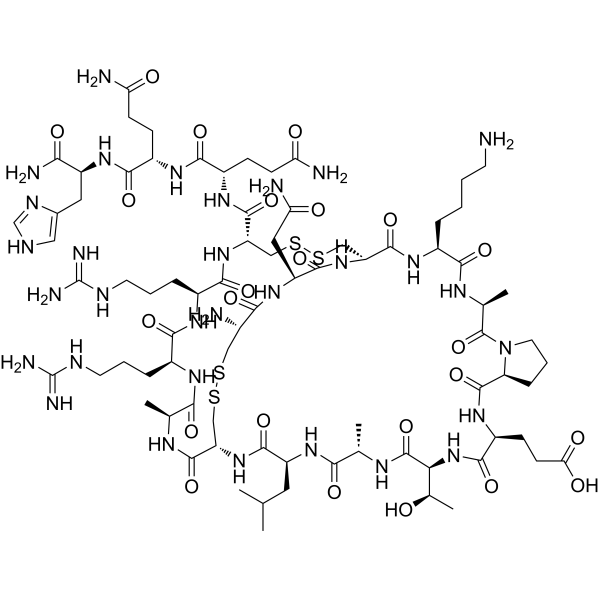
-
- HY-W803134
-
|
|
TGF-beta/Smad
|
Inflammation/Immunology
|
|
E/Z-SIS3 free base exhibits an inhibitory efficacy against smad3, exhibits an anti-fibrotic and anti-inflammatory effect through a TGF-β/smad3 signaling pathway .
|
-
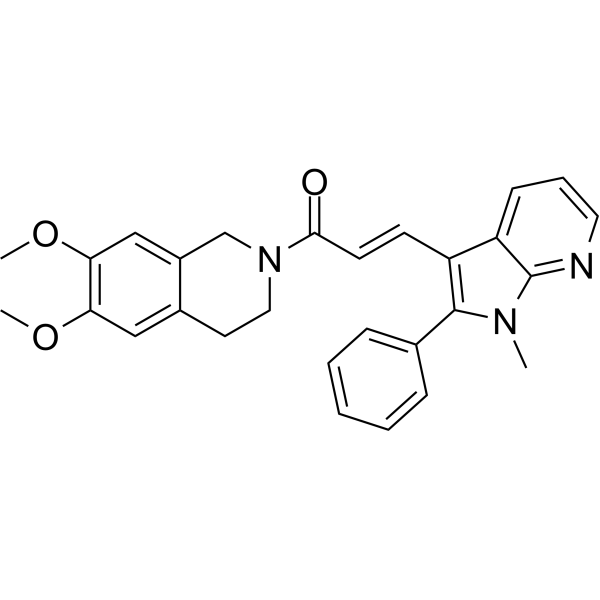
-
- HY-P0256A
-
|
Apamine TFA
|
Potassium Channel
|
Neurological Disease
Inflammation/Immunology
|
|
Apamin TFA (Apamine TFA) is an 18 amino acid peptide neurotoxin found in apitoxin (bee venom), is known as a specifically selective blocker of Ca 2+-activated K + (SK) channels and exhibits anti-inflammatory and anti-fibrotic activity .
|
-

-
- HY-112606
-
|
|
RXFP Receptor
|
Others
|
|
ML-290 is a first-in-class and potent relaxin/insulin-like family peptide receptor (RXFP1) agonist and activator of anti-fibrotic genes, with an EC50 of 94 nM . ML290 is a biased allosteric agonist at the relaxin receptor RXFP1.
|
-
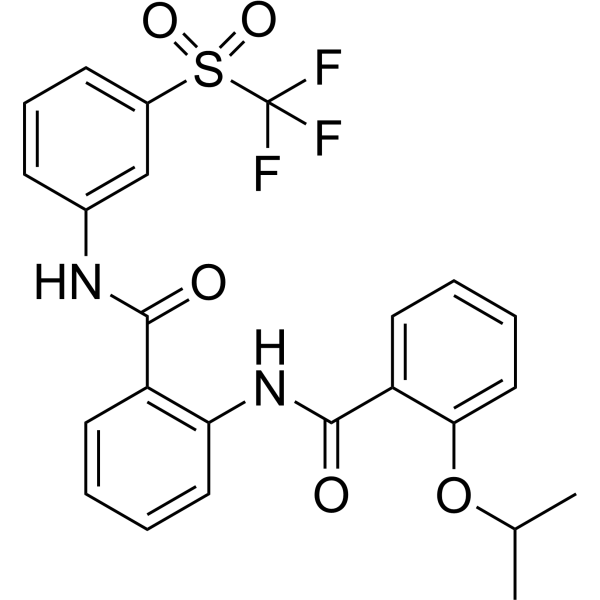
-
- HY-100775
-
|
Setogepram sodium; PBI-4050 sodium
|
|
|
|
Fezagepras (Setogepram) sodium acts as an orally active agonist for GPR40 and as an antagonist or inverse agonist for GPR84 . Fezagepras sodium decreases renal, liver and pancreatic fibrosis . Fezagepras sodium exerts anti-fibrotic, anti-inflammatory and anti-proliferative actions .
|
-

-
- HY-100775A
-
|
Setogepram; PBI-4050
|
Free Fatty Acid Receptor
GPR84
|
Metabolic Disease
Inflammation/Immunology
|
|
Fezagepras (Setogepram) acts as an orally active agonist for GPR40 and as an antagonist or inverse agonist for GPR84 . Fezagepras decreases renal, liver and pancreatic fibrosis . Fezagepras exerts anti-fibrotic, anti-inflammatory and anti-proliferative actions .
|
-
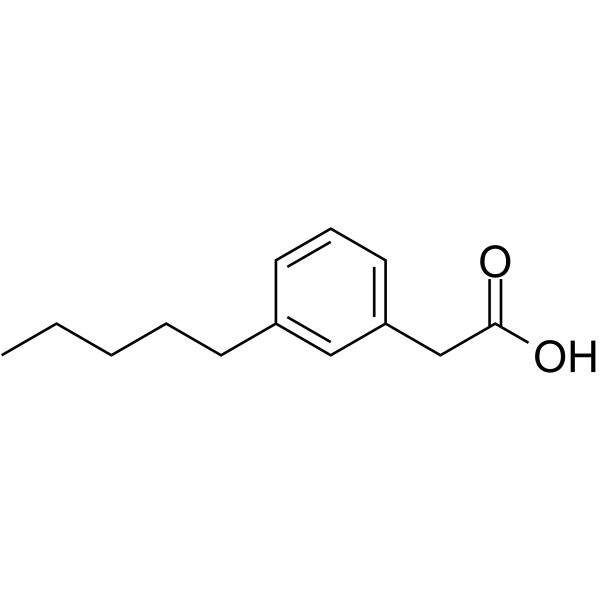
-
- HY-137978
-
|
GNS561
|
Others
|
Metabolic Disease
Inflammation/Immunology
Cancer
|
|
Ezurpimtrostat (compound 2-2) is a potent and orally active anti-fibrotic agent. Ezurpimtrostat can be used for the research of fibrosis, cancer, autophagy and cathepsins B (CTSB), L (CTSL) and D (CTSD) related diseases (extracted from patent WO2020048694 A1) .
|
-
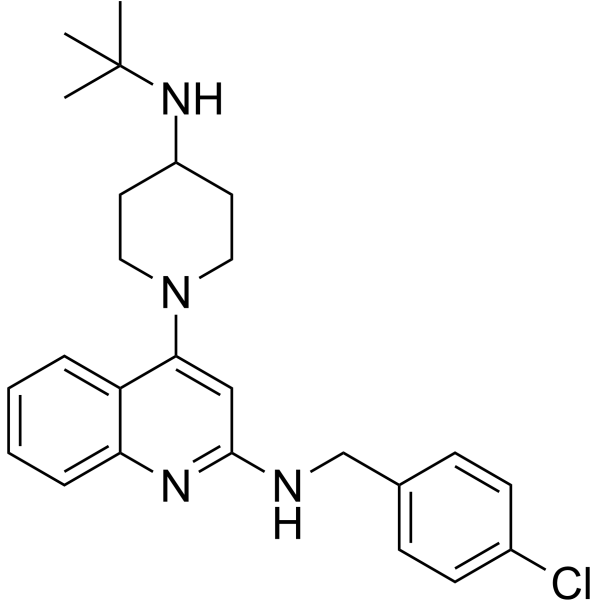
-
- HY-100495
-
FT011
1 Publications Verification
|
MMP
|
Inflammation/Immunology
|
|
FT011 is an anti-fibrotic agent, reduces mRNA expression of collagens I and III and inhibits collagen synthesis . FT011 is a click chemistry reagent, it contains an Alkyne group and can undergo copper-catalyzed azide-alkyne cycloaddition (CuAAc) with molecules containing Azide groups.
|
-
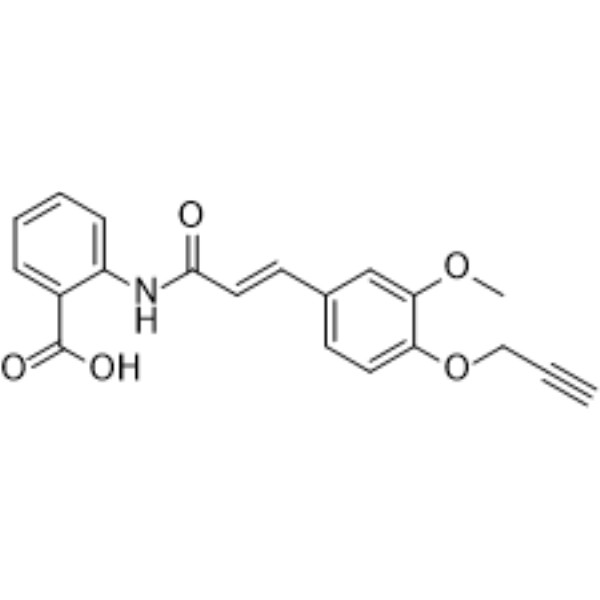
-
- HY-145855
-
|
|
TGF-β Receptor
|
Inflammation/Immunology
|
|
J-1063 is a potent, selective and orally active ALK5 inhibitor with an IC50 of 0.039 µM. J-1063 shows anti-fibrotic effect by the inhibition of inflammatory infiltration, collagen deposition, and hepatocytes necrosis. J-1063 has the potential for the research of liver fibrosis .
|
-
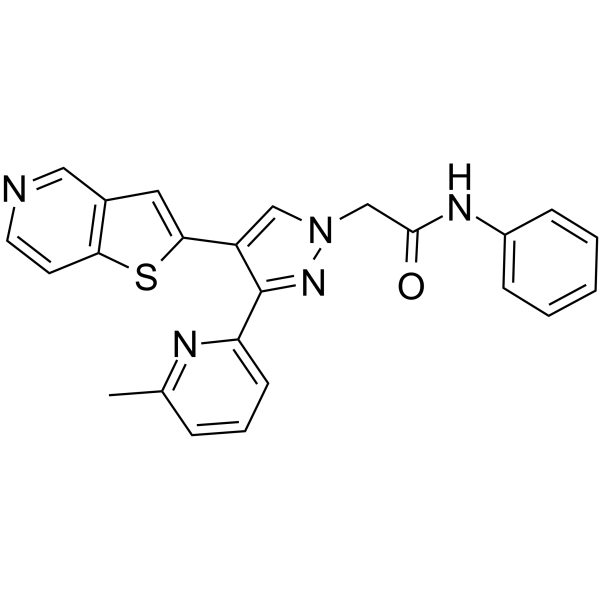
-
- HY-137978A
-
|
GNS561 hydrochloride
|
Others
|
Metabolic Disease
Inflammation/Immunology
Cancer
|
|
Ezurpimtrostat hydrochloride (compound 2-3) is a potent and orally active anti-fibrotic agent. Ezurpimtrostat hydrochloride reduces significantly the liver fibrosis in DEN (diethyl nitrosamine) cirrhotic rat model. Ezurpimtrostat hydrochloride can be used for the research of fibrosis, cancer, autophagy and cathepsins B (CTSB), L (CTSL) and D (CTSD) related diseases .
|
-
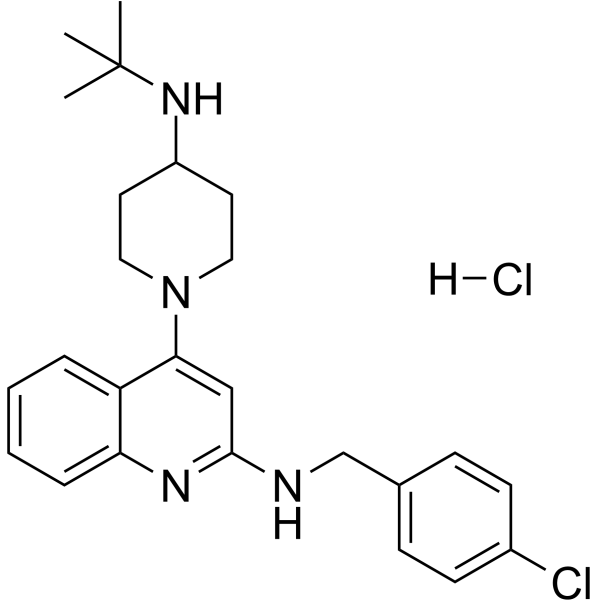
-
- HY-130242
-
|
|
Monoamine Oxidase
|
Inflammation/Immunology
|
|
PXS-5120A is a potent, irreversible fluoroallylamine inhibitor of Lysyl Oxidase-like 2/3 (LOXL2/3) with anti-fibrotic activity. PXS-5120A is >300-fold selective for LOXL2 (Ki of 83 nM; pIC50 of 8.4) over LOXL (pIC50 of 5.8) .
|
-
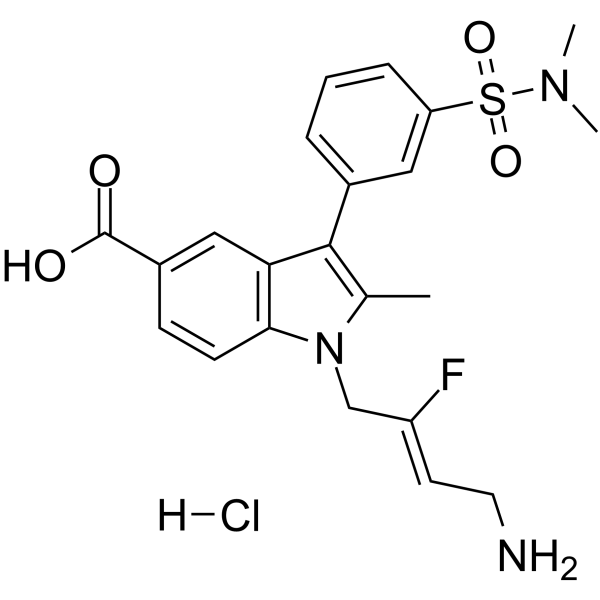
-
- HY-156119
-
|
|
Mixed Lineage Kinase
Necroptosis
|
Metabolic Disease
Cancer
|
|
MLKL-IN-6 (compound P28) is a mixed lineage kinase inhibitor targeting Mixed Lineage Kinase domain-like (MLKL). MLKL-IN-6 inhibits cell necrosis. MLKL-IN-6 inhibits MLKL phosphorylation and oligomerization during cell necrosis, inhibits immune cell death, and reduces the expression of adhesion factors. MLKL-IN-6 has low cytotoxicity, and it inhibits hepatic stellate cell activation, reduces liver fibrosis marker levels, and has anti-fibrotic effects .
|
-
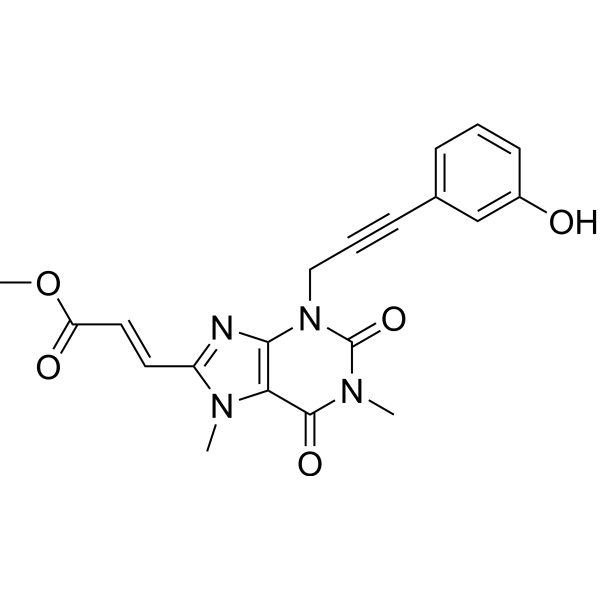
-
- HY-12403A
-
|
TXA127 acetate; Angiotensin (1-7) (acetate); Ang-(1-7) (acetate)
|
Angiotensin Receptor
Angiotensin-converting Enzyme (ACE)
Endogenous Metabolite
|
Cardiovascular Disease
Inflammation/Immunology
Endocrinology
|
|
Angiotensin 1-7 (Ang-(1-7)) acetate is an endogenous heptapeptide from the renin-angiotensin system (RAS) with a cardioprotective role due to its anti-inflammatory and anti-fibrotic activities in cardiac cells. Angiotensin 1-7 acetate inhibits purified canine ACE activity (IC50=0.65 μM). Angiotensin 1-7 acetate acts as a local synergistic modulator of kinin-induced vasodilation by inhibiting ACE and releasing nitric oxide. Angiotensin 1-7 acetate blocks Ang II-induced smooth muscle cell proliferation and hypertrophy and shows antiangiogenic and growth-inhibitory effects on the endothelium .
|
-
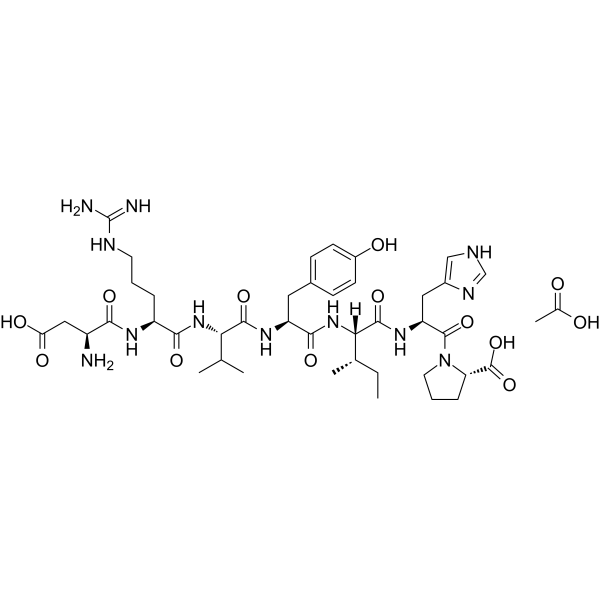
-
- HY-12403
-
|
TXA127; Angiotensin (1-7); Ang-(1-7)
|
Angiotensin Receptor
Angiotensin-converting Enzyme (ACE)
Endogenous Metabolite
|
Cardiovascular Disease
Inflammation/Immunology
Endocrinology
|
|
Angiotensin 1-7 (Ang-(1-7)) is an endogenous heptapeptide from the renin-angiotensin system (RAS) with a cardioprotective role due to its anti-inflammatory and anti-fibrotic activities in cardiac cells. Angiotensin 1-7 inhibits purified canine ACE activity (IC50=0.65 μM). Angiotensin 1-7 acts as a local synergistic modulator of kinin-induced vasodilation by inhibiting ACE and releasing nitric oxide. Angiotensin 1-7 blocks Ang II-induced smooth muscle cell proliferation and hypertrophy and shows antiangiogenic and growth-inhibitory effects on the endothelium. Angiotensin 1-7 shows anti-inflammatory activity .
|
-

-
- HY-100438
-
|
|
|
|
|
Hydronidone is a pyridine derivative and an antifibrotic agent for hepatic fibrosis .
|
-

-
- HY-134988
-
|
|
FXR
Phosphatase
Cytochrome P450
|
Inflammation/Immunology
|
|
EDP-305 is an orally active, potent and selective farnesoid X receptor (FXR) agonist, with EC50 values of 34 nM (chimeric FXR in CHO cells) and 8 nM (full-length FXR in HEK cells). EDP-305 shows a potent and consistent antifibrotic effect. EDP-305 can be used for primary biliary cholangitis (PBC) and non-alcoholic steatohepatitis (NASH) research .
|
-

-
- HY-P4890
-
-

-
- HY-119582
-
|
|
Others
|
Inflammation/Immunology
|
|
Safironil is an antifibrotic compound. Safironil is a competitive inhibitor of collagen protein synthesis. Safironil reduces liver fibrogenesis by inhibiting HSC activation .
|
-
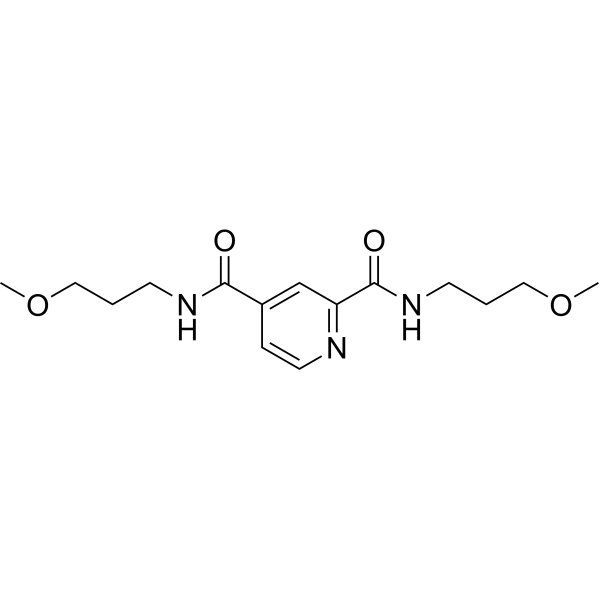
-
- HY-145555
-
|
DWN12088
|
DNA/RNA Synthesis
|
Inflammation/Immunology
|
|
Bersiporocin is a prolyl-tRNA synthetase inhibitor. Bersiporocin has an IC50 of ≤100 nM for phosphoribosylpyrophosphate synthetase (PRS). Bersiporocin can be used for the research of antifibrotic .
|
-
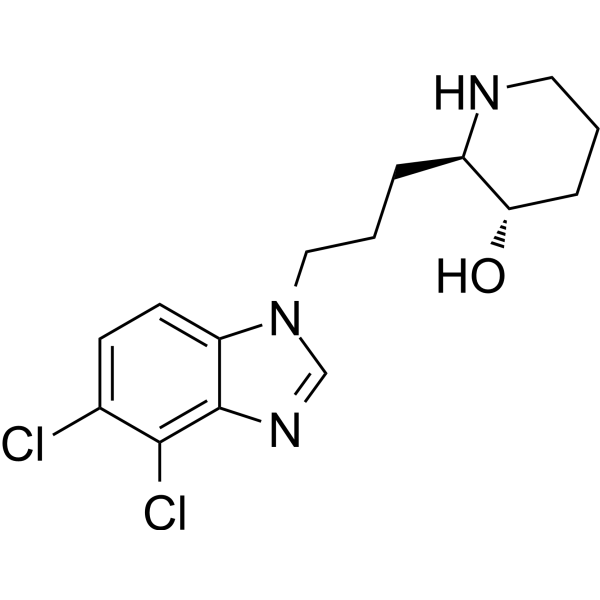
-
- HY-163093
-
|
|
Others
|
Cancer
|
|
ATX inhibitor 24 is a potent ATX inhibitor with IC50 of 7.51±0.72 nM that has anti-tumor effect .
|
-
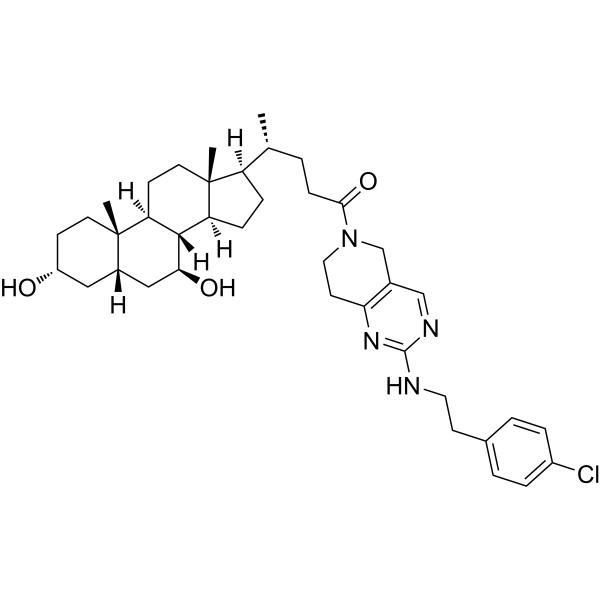
-
- HY-162137
-
|
|
Apoptosis
|
Inflammation/Immunology
|
|
Hepatoprotective agent-1 (compound 1b) is a hepatoprotective agenrt. Hepatoprotective agent-1 shows anti-inflammatory, antiapoptotic and antifibrotic effects .
|
-
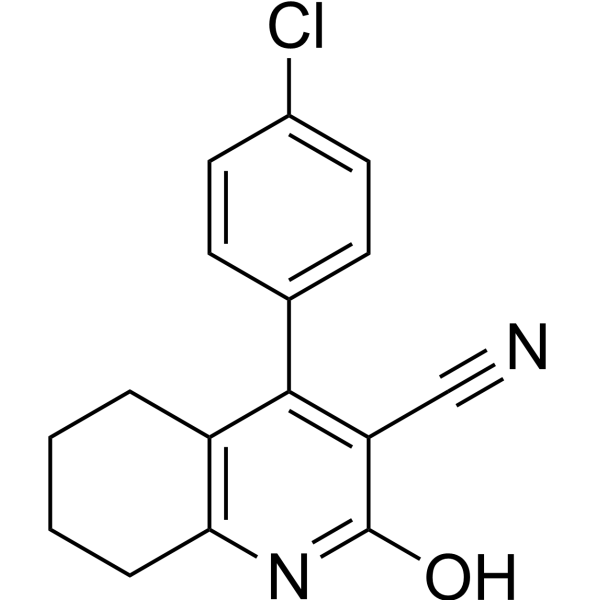
-
- HY-P4890A
-
-

-
- HY-101473
-
|
|
Integrin
|
Inflammation/Immunology
|
|
EMD527040 is a potent and highly selective αvβ6 antagonist with antifibrotic activities. EMD527040 can be used for carcinoma and liver fibrosis research .
|
-
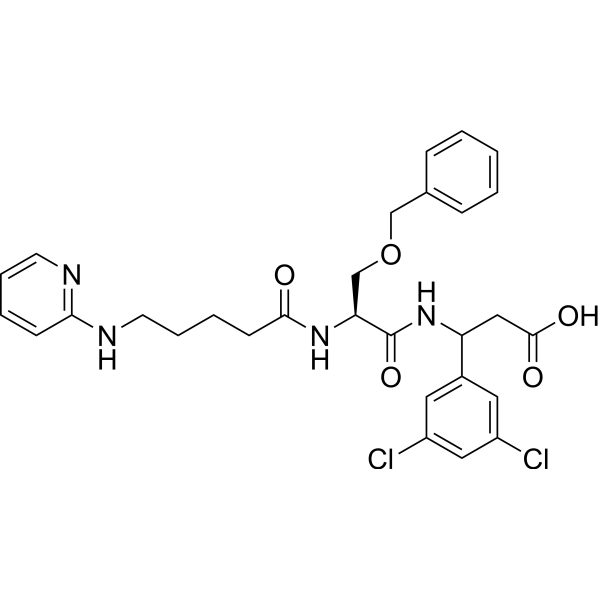
-
- HY-N1482
-
|
|
|
|
|
Methyl palmitate, an acaricidal compound occurring in Lantana camara, inhibits phagocytic activity and immune response. Methyl palmitate also posseses anti-inflammatory and antifibrotic effects .
|
-
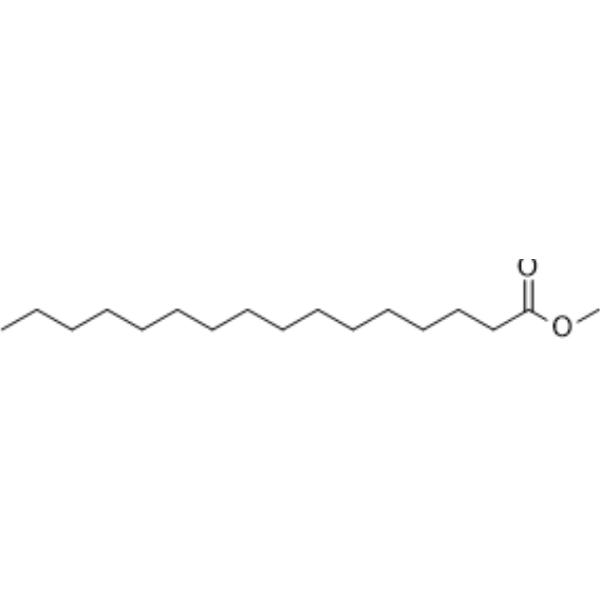
-
- HY-100445
-
|
|
|
|
|
αvβ1 integrin-IN-1 (Compound C8) is a potent and selective αvβ1 integrin inhibitor with an IC50 of 0.63 nM. Antifibrotic effects .
|
-
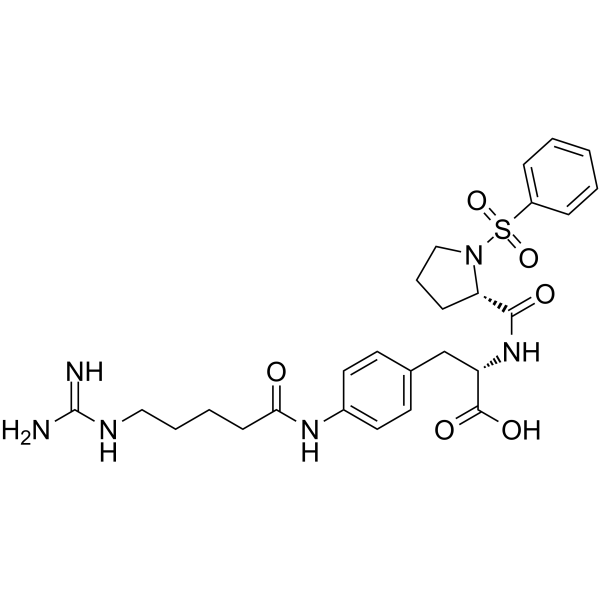
-
- HY-100445A
-
-
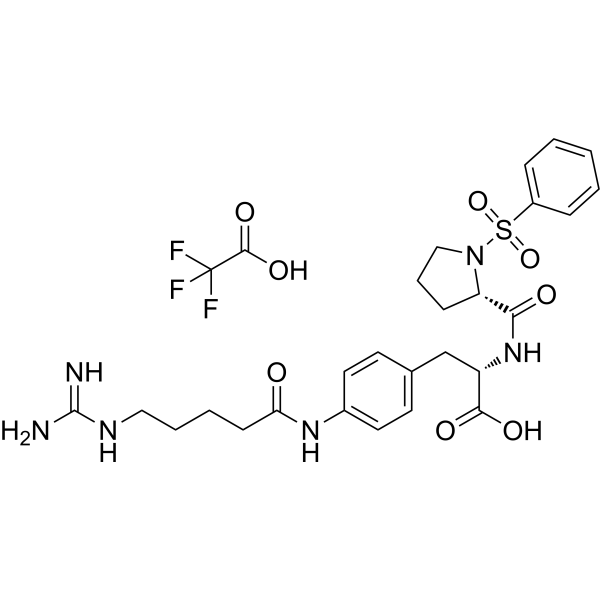
-
- HY-113926
-
|
|
Guanylate Cyclase
|
Cardiovascular Disease
|
|
BAY 60-2770 is a potent, selective, and orally active soluble guanylyl cyclase (sGC) activator. BAY 60-2770 increases the activity of sGC in a nitric oxide-independent manner. BAY 60-2770 shows antifibrotic effect .
|
-
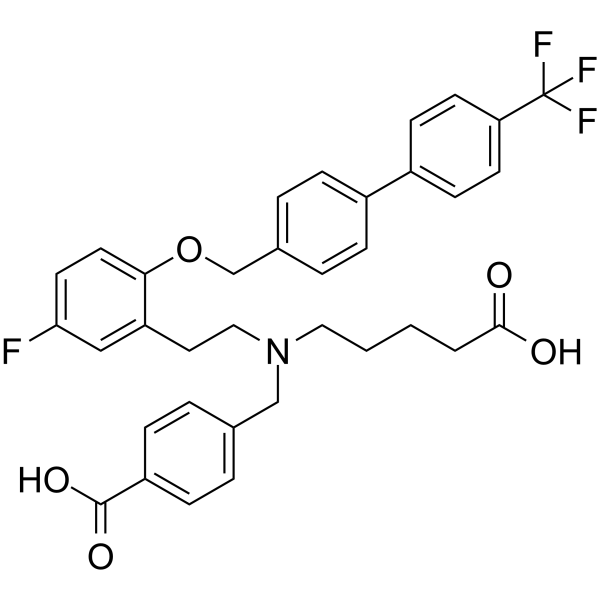
-
- HY-109083
-
|
GS-9674
|
FXR
Autophagy
|
Inflammation/Immunology
|
|
Cilofexor (GS-9674) is a potent, selective and orally active nonsteroidal FXR agonist with an EC50 of 43 nM. Cilofexor has anti-inflammatory and antifibrotic effects. Cilofexor has the potential for primary sclerosing cholangitis (PSC) and nonalcoholic steatohepatitis (NASH) research .
|
-

-
- HY-147243
-
|
ANG-3070
|
VEGFR
PDGFR
|
Cardiovascular Disease
Inflammation/Immunology
|
|
Ansornitinib is an orally active dual kinase inhibitor that inhibits platelet-derived growth factor receptor (PDGFR) and vascular endothelial growth factor receptor (VEGFR2). Ansornitinib can be used as an antifibrotic agent in lung, liver, kidney, and gastrointestinal fibrotic diseases .
|
-
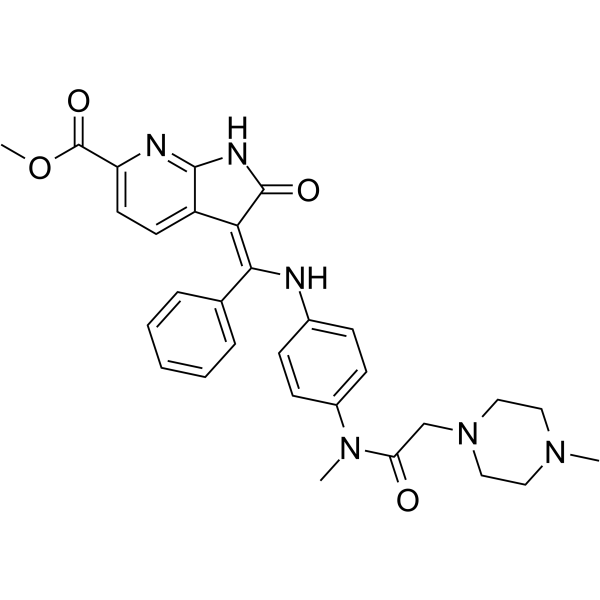
-
- HY-P1931
-
|
Uteroglobin(39-47)
|
Interleukin Related
|
Inflammation/Immunology
|
|
Antiflammin-1 is an anti-inflammatory peptide 1 (MQMKKVLDS). Antiflammin-1 is a derivative of uteroglobin. Antiflammin-1 has anti-inflammatory and antifibrotic actions in bleomycin (HY-108345)-induced lung injury .
|
-
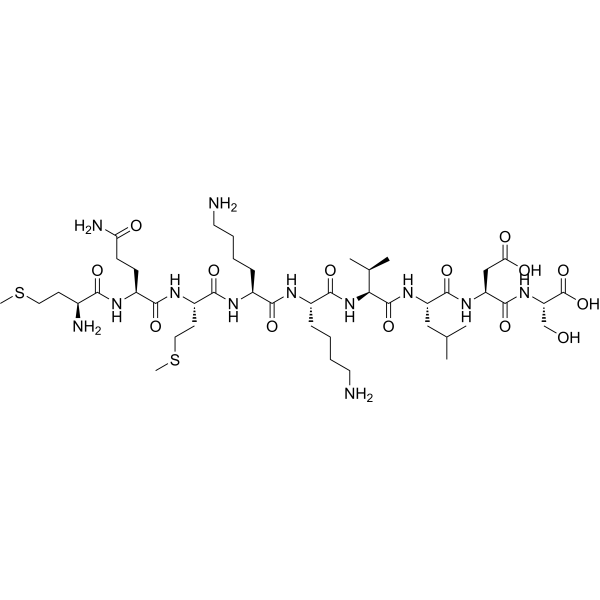
-
- HY-N0136
-
|
(+)-Dihydroquercetin; (+)-Taxifolin
|
Autophagy
Tyrosinase
|
Inflammation/Immunology
|
|
Taxifolin ((+)-Dihydroquercetin) exhibits important anti-tyrosinase activity. Taxifolin exhibits significant inhibitory activity against collagenase with an IC50 value of 193.3 μM . Taxifolin is an important natural compound with antifibrotic activity. Taxifolin is a free radical scavenger with antioxidant capacity .
|
-
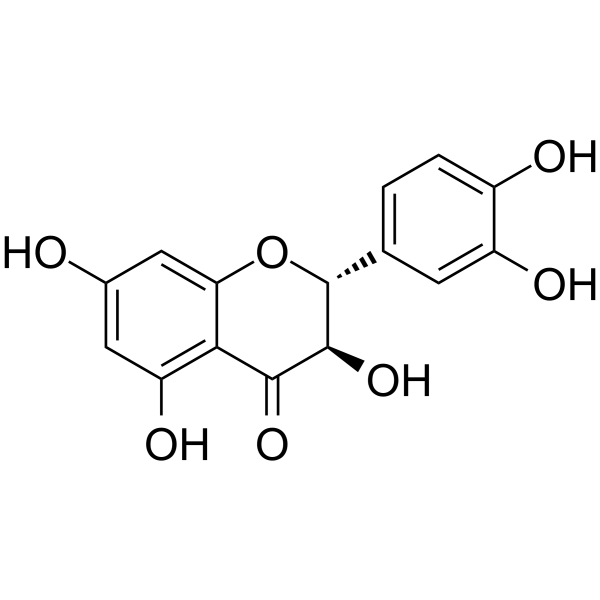
-
- HY-N1482S1
-
|
|
Parasite
|
Inflammation/Immunology
|
|
Methyl palmitate-d31 is the deuterium labeled Methyl palmitate. Methyl palmitate, an acaricidal compound occurring in green walnut husks, inhibits phagocytic activity and immune response. Methyl palmitate also posseses anti-inflammatory and antifibrotic effects[1][2][3].
|
-
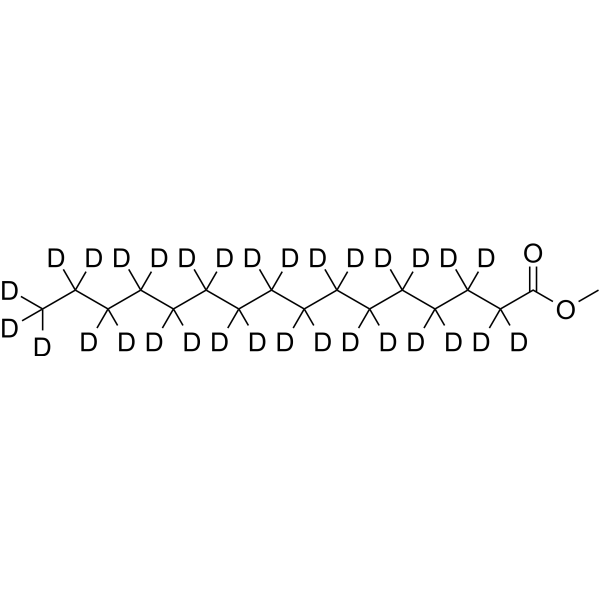
-
- HY-103070
-
|
|
MMP
|
Inflammation/Immunology
|
|
PythiDC is a selective collagen prolyl 4-hydroxylase (CP4H1) inhibitor with an IC50 value of 4.0 μM. PythiDC can be used as a CP4H probe and also can be used for the development of a new class of antifibrotic and antimetastatic agents .
|
-
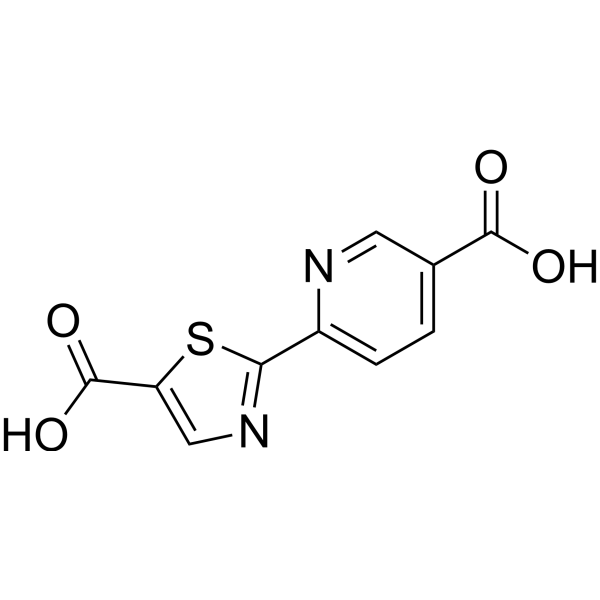
-
- HY-N0136A
-
|
(±)-Dihydroquercetin
|
Autophagy
Tyrosinase
|
Inflammation/Immunology
|
|
(±)-Taxifolin ((±)-Dihydroquercetin) is the racemate of Taxifolin. Taxifolin exhibits important anti-tyrosinase activity. Taxifolin exhibits significant inhibitory activity against collagenase with an IC50 value of 193.3 μM . Taxifolin is an important natural compound with antifibrotic activity. Taxifolin is a free radical scavenger with antioxidant capacity .
|
-
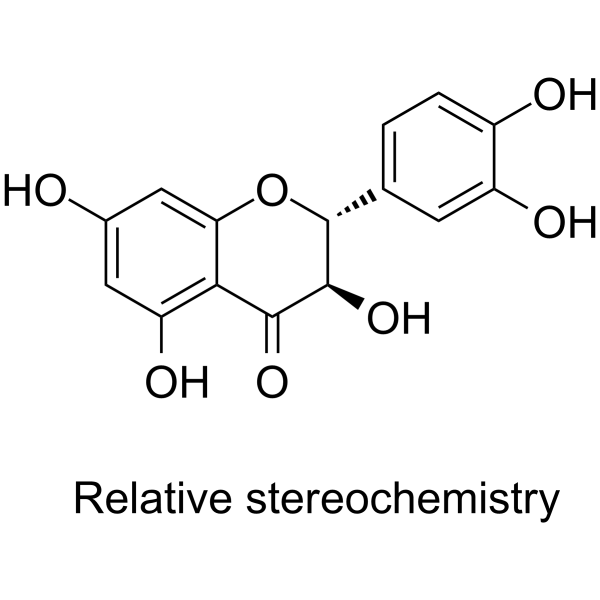
-
- HY-N1482S
-
|
|
Parasite
|
Inflammation/Immunology
|
|
Methyl palmitate- 13C16 is the 13C labeled Methyl palmitate. Methyl palmitate, an acaricidal compound occurring in green walnut husks, inhibits phagocytic activity and immune response. Methyl palmitate also posseses anti-inflammatory and antifibrotic effects[1][2][3].
|
-
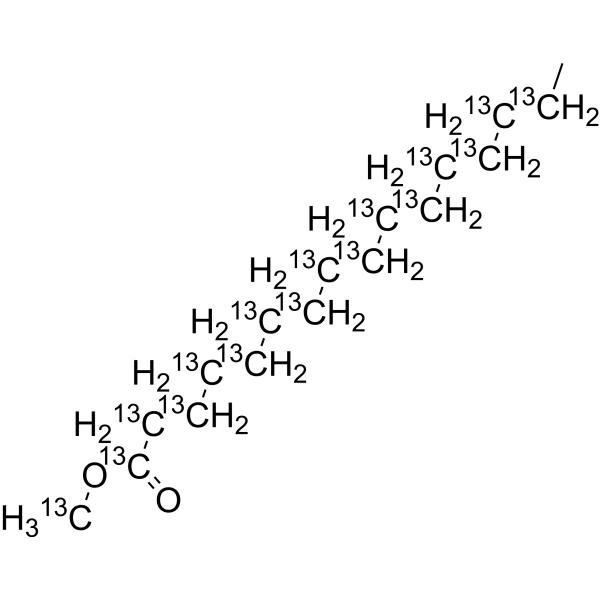
-
- HY-P99351
-
|
Anti-MMP9 Reference Antibody (andecaliximab)
|
MMP
|
Cancer
|
|
Andecaliximab is a recombinant chimeric IgG4 monoclonal antibody (mAb) targets matrix metalloproteinase 9 (MMP9). Andecaliximab shows the antifibrotic efficacy in idiopathic pulmonary fibrosis mouse models. Andecaliximab can be used for the research of gastric adenocarcinoma and idiopathic pulmonary fibrosis (IPF) .
|
-

-
- HY-N0136B
-
|
(-)-Dihydroquercetin
|
Tyrosinase
|
Inflammation/Immunology
|
|
(-)-Taxifolin is the less active enantiomer of Taxifolin. Taxifolin exhibits important anti-tyrosinase activity. Taxifolin exhibits significant inhibitory activity against collagenase with an IC50 value of 193.3 μM . Taxifolin is an important natural compound with antifibrotic activity. Taxifolin is a free radical scavenger with antioxidant capacity .
|
-
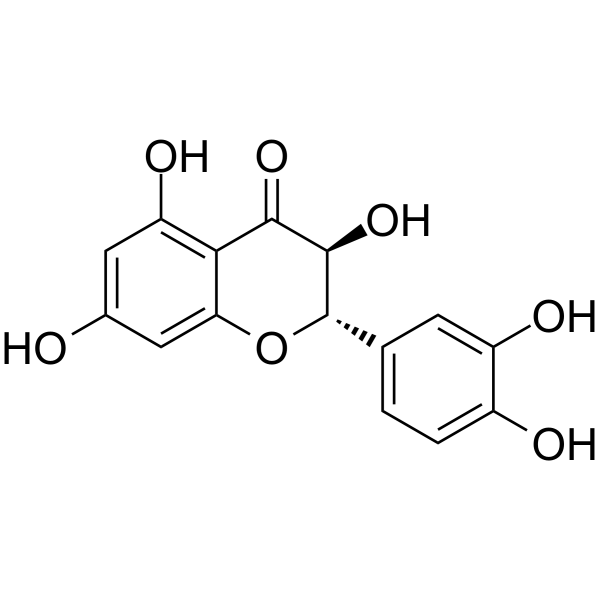
-
- HY-111432
-
|
|
Ras
|
Others
|
|
CCG-232601 (compound 8f) is a potent and orally active Rho/MRTF/SRF transcriptional pathway inhibitor. CCG-232601 inhibits the development of Bleomycin-induced dermal fibrosis in mice. CCG-232601 has the potential for the research of antifibrotic for systemic scleroderma .
|
-
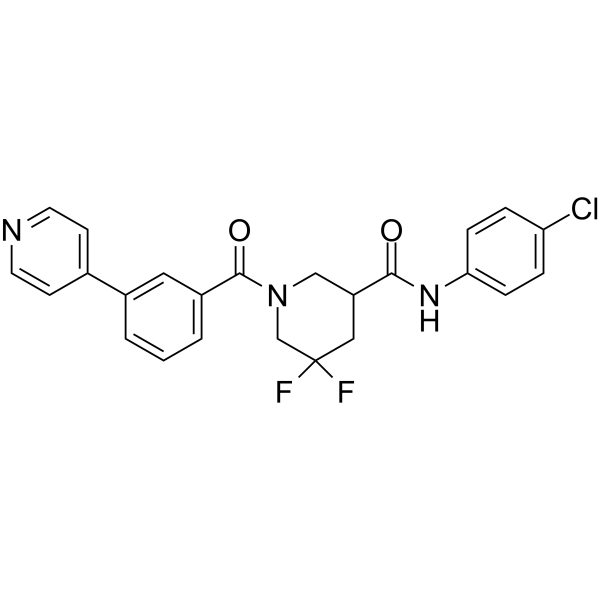
-
- HY-P3108
-
-
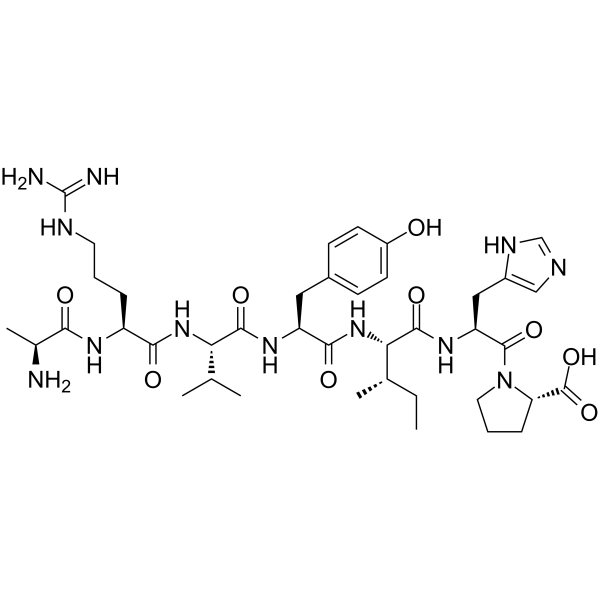
-
- HY-P0266B
-
|
Ac-SDKP acetate
|
Angiotensin-converting Enzyme (ACE)
|
Inflammation/Immunology
|
|
N-Acetyl-Ser-Asp-Lys-Pro (Ac-SDKP) acetate is a specific substrate for the N-terminal active site of angiotensin-converting enzyme (ACE). N-Acetyl-Ser-Asp-Lys-Pro acetate is a natural inhibitor of pluripotent hematopoietic stem cell proliferation. Anti-inflammatory and antifibrotic properties .
|
-
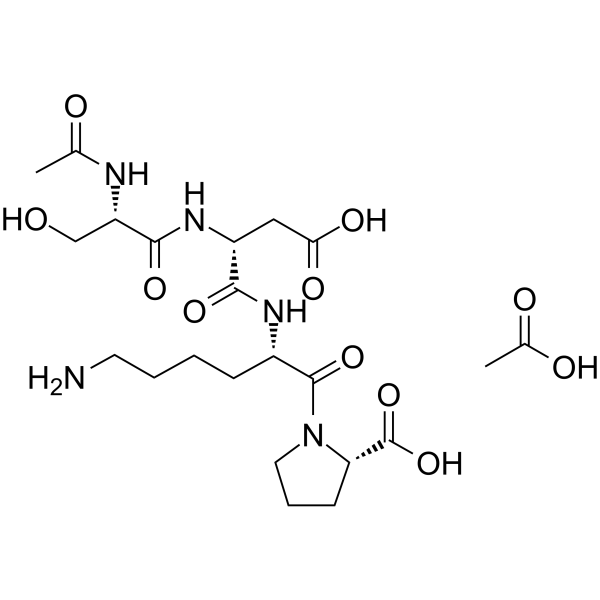
- HY-B0673
-
Pirfenidone
Maximum Cited Publications
39 Publications Verification
AMR69
|
TGF-beta/Smad
CCR
|
Inflammation/Immunology
Cancer
|
|
Pirfenidone (AMR69) is an antifibrotic agent that attenuates CCL2 and CCL12 production in fibrocyte cells. Pirfenidone has growth-inhibitory effect and reduces TGF-β2 protein levels in human glioma cell lines. Pirfenidone also has anti-inflammatory activities .
|
-
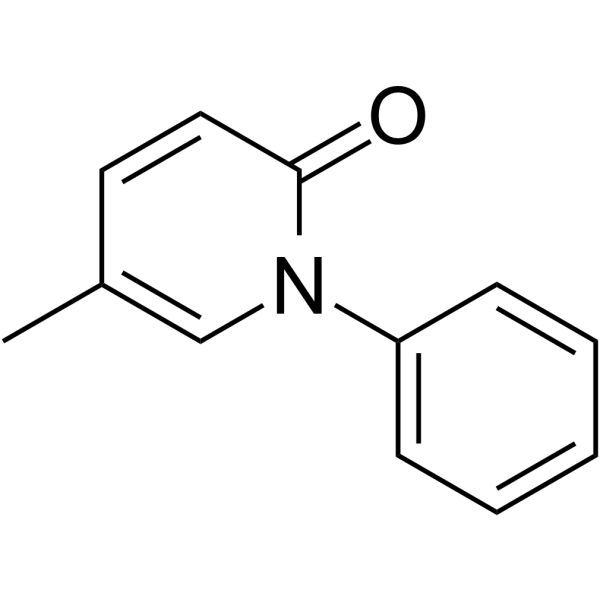
- HY-19149
-
|
|
|
|
|
Ro24-7429 is a potent and orally active HIV-1 transactivator protein Tat antagonist. Ro24-7429 is also a runt-related transcription factor 1 (RUNX1) inhibitor. Ro24-7429 has anti-HIV, antifibrotic and anti-inflammatory effects .
|
-
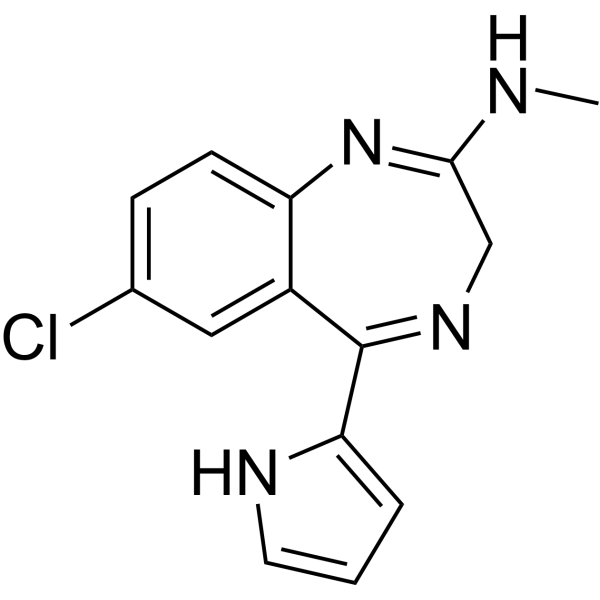
- HY-N0136S
-
|
(+)-Dihydroquercetin-d3; (+)-Taxifolin-d3
|
Isotope-Labeled Compounds
Autophagy
Tyrosinase
|
Inflammation/Immunology
|
|
Taxifolin-d3 is deuterium labeled Taxifolin. Taxifolin ((+)-Dihydroquercetin) exhibits important anti-tyrosinase activity. Taxifolin exhibits significant inhibitory activity against collagenase with an IC50 value of 193.3 μM[1]. Taxifolin is an important natural compound with antifibrotic activity. Taxifolin is a free radical scavenger with antioxidant capacity[2].
|
-
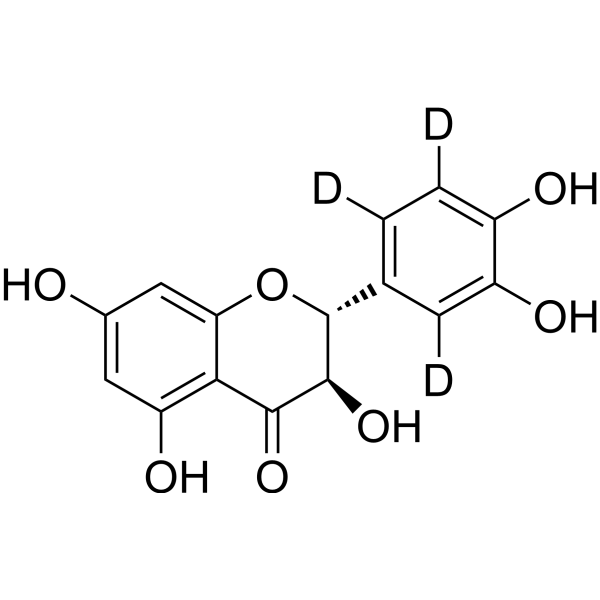
- HY-149205
-
|
|
PI3K
ERK
|
Inflammation/Immunology
|
|
CXJ-2 is a cyclic peptide, and exhibits moderate affinity toward elastin derived peptides (EDPs). CXJ-2 exhibits potent activities to inhibit the PI3K/ERK pathway and decrease hepatic stellate cell proliferation and migration. CXJ-2 possesses potent antifibrotic efficacy .
|
-
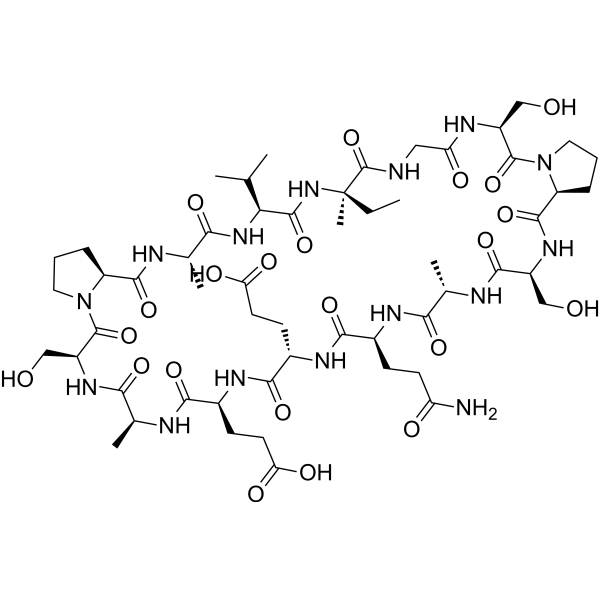
- HY-121246
-
|
AKF-PD
|
PI3K
Akt
|
Inflammation/Immunology
|
|
Fluorofenidone (AKF-PD), an analogue of AMR69, shows equivalent antifibrotic activity, lower toxicity and longer half-life. Fluorofenidone (AKF-PD) attenuates the progression of renal interstitial fibrosis partly by suppressing NADPH oxidase and extracellular matrix (ECM) deposition via the PI3K/Akt signalling pathway .
|
-
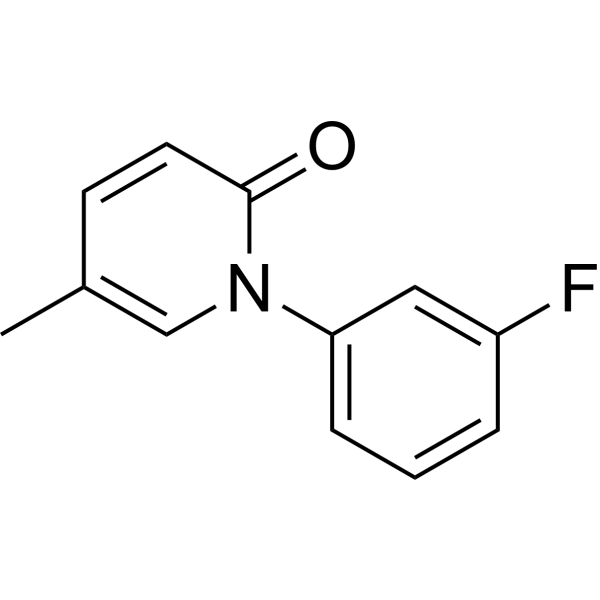
- HY-B0673S
-
|
AMR69-d5
|
TGF-beta/Smad
CCR
|
Inflammation/Immunology
Cancer
|
|
Pirfenidone-d5 is a deuterium labeled Pirfenidone. Pirfenidone is an antifibrotic agent that attenuates CCL2 and CCL12 production in fibrocyte cells. Pirfenidone has growth-inhibitory effect and reduces TGF-β2 protein levels in human glioma cell lines. Pirfenidone also has anti-inflammatory activities[1][2][3].
|
-
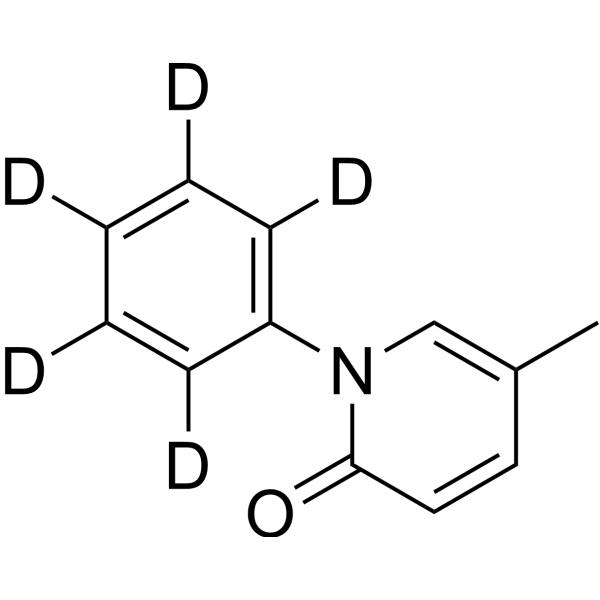
- HY-17002
-
|
IPD 1151T
|
Interleukin Related
|
Inflammation/Immunology
|
|
Suplatast Tosilate (IPD 1151T) is an orally active Th2 cytokine inhibitor which can inhibit both IL-4 and IL-5 production from Th2 cells and suppress IgE synthesis. Suplatast Tosilate is an anti-allergic agent. Suplatast Tosilate has antiasthmatic, anti-inflammatory and antifibrotic activity .
|
-
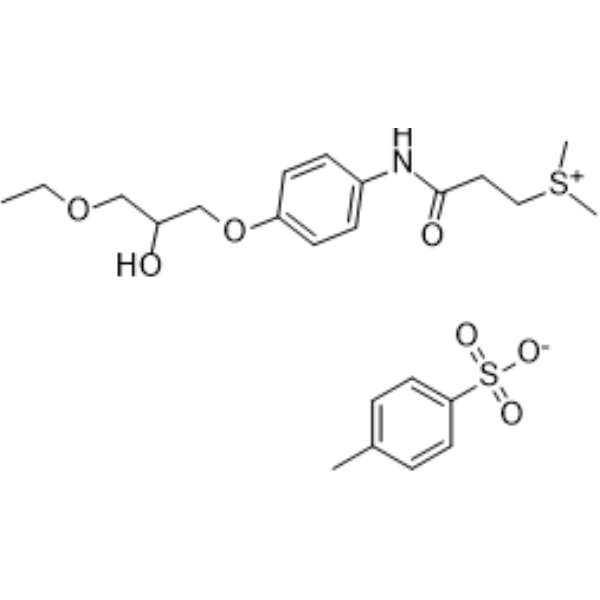
- HY-156397
-
|
|
AMPK
|
Inflammation/Immunology
Cancer
|
|
HTH-02-006 is a NUAK2 inhibitor (IC50?=?126?nM). HTH-02-006 reduces levels of phosphorylated MYPT1 in HuCCT-1 cells. HTH-02-006 inhibits YAP-driven cell proliferation, hepatomegaly and tumorigenesis. HTH-02-006 also has antifibrotic protective effect .
|
-

- HY-121246S
-
|
AKF-PD-d3
|
Isotope-Labeled Compounds
Akt
PI3K
|
Inflammation/Immunology
|
|
Fluorofenidone-d3 is deuterium labeled Fluorofenidone. Fluorofenidone (AKF-PD), an analogue of AMR69, shows equivalent antifibrotic activity, lower toxicity and longer half-life. Fluorofenidone (AKF-PD) attenuates the progression of renal interstitial fibrosis partly by suppressing NADPH oxidase and extracellular matrix (ECM) deposition via the PI3K/Akt signalling pathway[1][2].
|
-
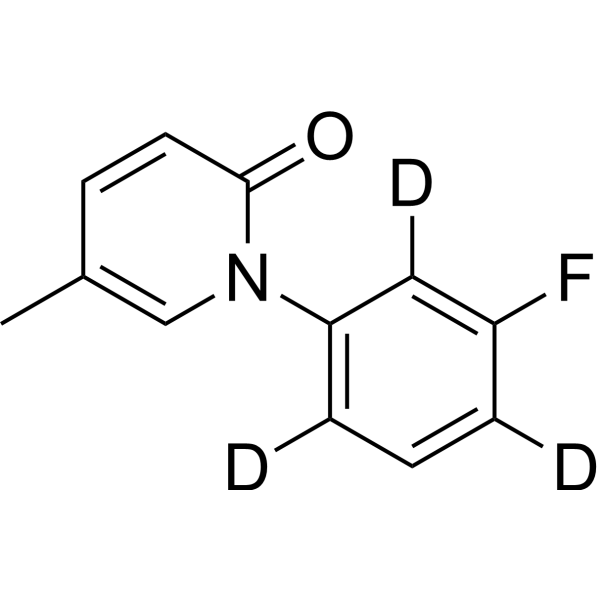
- HY-137464A
-
OATD-01
1 Publications Verification
|
Others
|
Inflammation/Immunology
|
|
OATD-01 is a highly potent, first-in-class, orally active and selective chitinase inhibitor with low nanomolar activity toward CHIT1 (hCHIT1,IC50=23 nM). OATD-01 shows excellect PK profile in multiple species and is selectivity against a panel of other off-targets. OATD-01 exhibits significant antifibrotic efficacy in vivo and can be used for pulmonary fibrosis (IPF) research .
|
-

- HY-138995
-
|
|
Deubiquitinase
|
Cancer
|
|
IMP-1710 is a potent and selective deubiquitylating enzyme UCHL1 inhibitor with an IC50 value of 38 nM. IMP-1710 has antifibrotic activity. IMP-1710 is a UCHL1 probe to identify and quantify target proteins in intact human cells . IMP-1710 is a click chemistry reagent, it contains an Alkyne group and can undergo copper-catalyzed azide-alkyne cycloaddition (CuAAc) with molecules containing Azide groups.
|
-
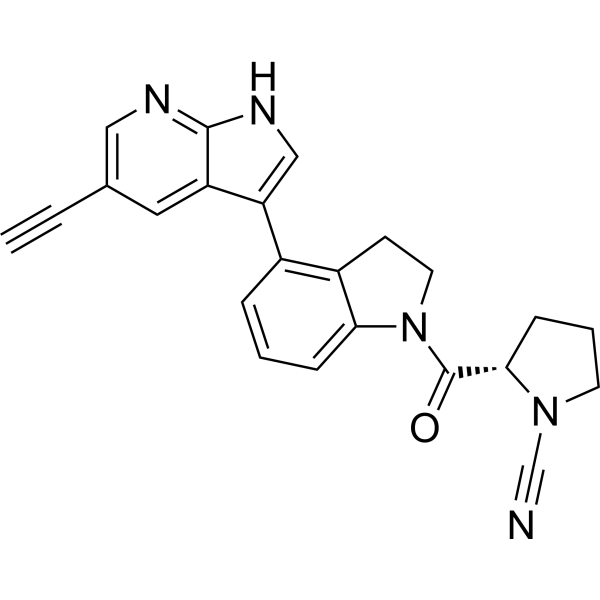
- HY-N0136S1
-
|
(±)-Dihydroquercetin-13C3
|
Autophagy
Tyrosinase
|
Inflammation/Immunology
|
|
(±)-Taxifolin-13C3 ((±)-Dihydroquercetin-13C3) is a derivative of (±)-Taxifolin, labeled with 13C3. (±)-Taxifolin is the racemate of Taxifolin. Taxifolin exhibits important anti-tyrosinase activity. Taxifolin exhibits significant inhibitory activity against collagenase with an IC50 value of 193.3 μM . Taxifolin is an important natural compound with antifibrotic activity. Taxifolin is a free radical scavenger with antioxidant capacity .
|
-
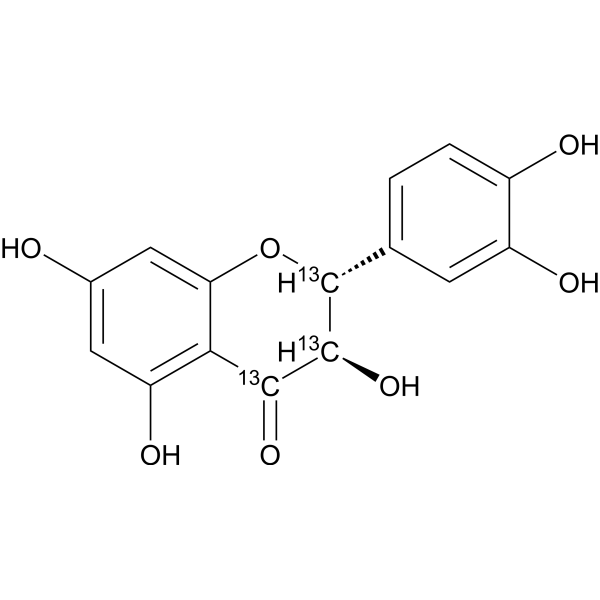
- HY-P3624
-
|
|
Guanylate Cyclase
|
Cardiovascular Disease
|
|
Cenderitide is a potent agonist of particulate guanylyl cyclase receptor (pGC). Cenderitide is a natriuretic peptide (NP) composed of C-type natriuretic peptide (CNP) fused to the C-terminus of Dendroaspis natriuretic peptide (DNP). Cenderitide activates both pGC-A and pGC-B, activates the second messenger cGMP, suppresses aldosterone, and preserves GFR without reducing blood pressure. Cenderitide can be used for heart failure research .
|
-
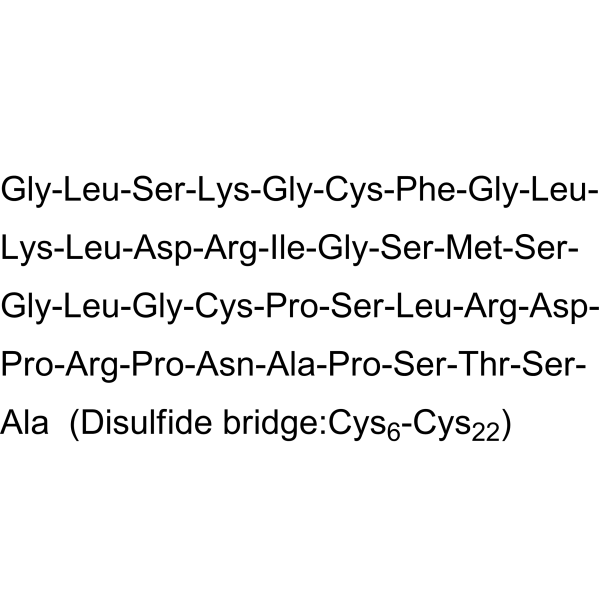
| Cat. No. |
Product Name |
Target |
Research Area |
-
- HY-P3618
-
|
|
Somatostatin Receptor
|
Neurological Disease
|
|
Cortistatin 29 is a neuropeptide. Cortistatin 29 alleviates neuropathic pain. Cortistatin 29 binds with high affinity all somatostatin (SS) receptor subtypes and shows IC50 values of 2.8, 7.1, 0.2, 3.0, 13.7 nM for SSTR1, SSTR2, SSTR3, SSTR4, SSTR5, respectively. Cortistatin 29 shows anti-fibrotic effects .
|
-
- HY-P0256
-
Apamin
3 Publications Verification
Apamine
|
Potassium Channel
|
Neurological Disease
Inflammation/Immunology
|
|
Apamin (Apamine) is an 18 amino acid peptide neurotoxin found in apitoxin (bee venom), is known as a specifically selective blocker of Ca 2+-activated K + (SK) channels and exhibits anti-inflammatory and anti-fibrotic activity .
|
-
- HY-P0256A
-
|
Apamine TFA
|
Potassium Channel
|
Neurological Disease
Inflammation/Immunology
|
|
Apamin TFA (Apamine TFA) is an 18 amino acid peptide neurotoxin found in apitoxin (bee venom), is known as a specifically selective blocker of Ca 2+-activated K + (SK) channels and exhibits anti-inflammatory and anti-fibrotic activity .
|
-
- HY-12403A
-
|
TXA127 acetate; Angiotensin (1-7) (acetate); Ang-(1-7) (acetate)
|
Angiotensin Receptor
Angiotensin-converting Enzyme (ACE)
Endogenous Metabolite
|
Cardiovascular Disease
Inflammation/Immunology
Endocrinology
|
|
Angiotensin 1-7 (Ang-(1-7)) acetate is an endogenous heptapeptide from the renin-angiotensin system (RAS) with a cardioprotective role due to its anti-inflammatory and anti-fibrotic activities in cardiac cells. Angiotensin 1-7 acetate inhibits purified canine ACE activity (IC50=0.65 μM). Angiotensin 1-7 acetate acts as a local synergistic modulator of kinin-induced vasodilation by inhibiting ACE and releasing nitric oxide. Angiotensin 1-7 acetate blocks Ang II-induced smooth muscle cell proliferation and hypertrophy and shows antiangiogenic and growth-inhibitory effects on the endothelium .
|
-
- HY-12403
-
Talfirastide
Maximum Cited Publications
9 Publications Verification
TXA127; Angiotensin (1-7); Ang-(1-7)
|
Angiotensin Receptor
Angiotensin-converting Enzyme (ACE)
Endogenous Metabolite
|
Cardiovascular Disease
Inflammation/Immunology
Endocrinology
|
|
Angiotensin 1-7 (Ang-(1-7)) is an endogenous heptapeptide from the renin-angiotensin system (RAS) with a cardioprotective role due to its anti-inflammatory and anti-fibrotic activities in cardiac cells. Angiotensin 1-7 inhibits purified canine ACE activity (IC50=0.65 μM). Angiotensin 1-7 acts as a local synergistic modulator of kinin-induced vasodilation by inhibiting ACE and releasing nitric oxide. Angiotensin 1-7 blocks Ang II-induced smooth muscle cell proliferation and hypertrophy and shows antiangiogenic and growth-inhibitory effects on the endothelium. Angiotensin 1-7 shows anti-inflammatory activity .
|
-
- HY-P4890
-
-
- HY-P4890A
-
-
- HY-P1931
-
|
Uteroglobin(39-47)
|
Interleukin Related
|
Inflammation/Immunology
|
|
Antiflammin-1 is an anti-inflammatory peptide 1 (MQMKKVLDS). Antiflammin-1 is a derivative of uteroglobin. Antiflammin-1 has anti-inflammatory and antifibrotic actions in bleomycin (HY-108345)-induced lung injury .
|
-
- HY-P3108
-
-
- HY-P0266B
-
|
Ac-SDKP acetate
|
Angiotensin-converting Enzyme (ACE)
|
Inflammation/Immunology
|
|
N-Acetyl-Ser-Asp-Lys-Pro (Ac-SDKP) acetate is a specific substrate for the N-terminal active site of angiotensin-converting enzyme (ACE). N-Acetyl-Ser-Asp-Lys-Pro acetate is a natural inhibitor of pluripotent hematopoietic stem cell proliferation. Anti-inflammatory and antifibrotic properties .
|
-
- HY-149205
-
|
|
PI3K
ERK
|
Inflammation/Immunology
|
|
CXJ-2 is a cyclic peptide, and exhibits moderate affinity toward elastin derived peptides (EDPs). CXJ-2 exhibits potent activities to inhibit the PI3K/ERK pathway and decrease hepatic stellate cell proliferation and migration. CXJ-2 possesses potent antifibrotic efficacy .
|
-
- HY-P3624
-
|
|
Guanylate Cyclase
|
Cardiovascular Disease
|
|
Cenderitide is a potent agonist of particulate guanylyl cyclase receptor (pGC). Cenderitide is a natriuretic peptide (NP) composed of C-type natriuretic peptide (CNP) fused to the C-terminus of Dendroaspis natriuretic peptide (DNP). Cenderitide activates both pGC-A and pGC-B, activates the second messenger cGMP, suppresses aldosterone, and preserves GFR without reducing blood pressure. Cenderitide can be used for heart failure research .
|
| Cat. No. |
Product Name |
Target |
Research Area |
-
- HY-P99351
-
|
Anti-MMP9 Reference Antibody (andecaliximab)
|
MMP
|
Cancer
|
|
Andecaliximab is a recombinant chimeric IgG4 monoclonal antibody (mAb) targets matrix metalloproteinase 9 (MMP9). Andecaliximab shows the antifibrotic efficacy in idiopathic pulmonary fibrosis mouse models. Andecaliximab can be used for the research of gastric adenocarcinoma and idiopathic pulmonary fibrosis (IPF) .
|
| Cat. No. |
Product Name |
Category |
Target |
Chemical Structure |
-
- HY-N6928
-
-

-
- HY-N0664
-
|
|
Infection
Structural Classification
Eucommia ulmoides Oliver
Iridoids
Neurological Disease
Classification of Application Fields
Terpenoids
Source classification
Eucommiaceae
Plants
Inflammation/Immunology
Disease Research Fields
|
Bacterial
|
|
Aucubin, an iridoid glucoside, is isolated from Plantago asiatica, Eucommia ulmoides, the leaves of Aucuba japonica and more recently from butterfly larva. Aucubin has many biological activities, such as antioxidant, anti-aging, anti-inflammatory, antimicrobial, anti-fibrotic, anti-cancer, hepatoprotective, neuroprotective and osteoprotective effects .
|
-

-
- HY-12403A
-
-

-
- HY-12403
-
-

-
- HY-N0136
-
-

-
- HY-N0136A
-
-

-
- HY-N0136B
-
-

| Cat. No. |
Product Name |
Chemical Structure |
-
- HY-N1482S1
-
|
|
|
Methyl palmitate-d31 is the deuterium labeled Methyl palmitate. Methyl palmitate, an acaricidal compound occurring in green walnut husks, inhibits phagocytic activity and immune response. Methyl palmitate also posseses anti-inflammatory and antifibrotic effects[1][2][3].
|
-

-
- HY-B0673S
-
|
|
|
Pirfenidone-d5 is a deuterium labeled Pirfenidone. Pirfenidone is an antifibrotic agent that attenuates CCL2 and CCL12 production in fibrocyte cells. Pirfenidone has growth-inhibitory effect and reduces TGF-β2 protein levels in human glioma cell lines. Pirfenidone also has anti-inflammatory activities[1][2][3].
|
-

-
- HY-N1482S
-
|
|
|
Methyl palmitate- 13C16 is the 13C labeled Methyl palmitate. Methyl palmitate, an acaricidal compound occurring in green walnut husks, inhibits phagocytic activity and immune response. Methyl palmitate also posseses anti-inflammatory and antifibrotic effects[1][2][3].
|
-

-
- HY-N0136S
-
|
|
|
Taxifolin-d3 is deuterium labeled Taxifolin. Taxifolin ((+)-Dihydroquercetin) exhibits important anti-tyrosinase activity. Taxifolin exhibits significant inhibitory activity against collagenase with an IC50 value of 193.3 μM[1]. Taxifolin is an important natural compound with antifibrotic activity. Taxifolin is a free radical scavenger with antioxidant capacity[2].
|
-

-
- HY-121246S
-
|
|
|
Fluorofenidone-d3 is deuterium labeled Fluorofenidone. Fluorofenidone (AKF-PD), an analogue of AMR69, shows equivalent antifibrotic activity, lower toxicity and longer half-life. Fluorofenidone (AKF-PD) attenuates the progression of renal interstitial fibrosis partly by suppressing NADPH oxidase and extracellular matrix (ECM) deposition via the PI3K/Akt signalling pathway[1][2].
|
-

-
- HY-N0136S1
-
|
|
|
(±)-Taxifolin-13C3 ((±)-Dihydroquercetin-13C3) is a derivative of (±)-Taxifolin, labeled with 13C3. (±)-Taxifolin is the racemate of Taxifolin. Taxifolin exhibits important anti-tyrosinase activity. Taxifolin exhibits significant inhibitory activity against collagenase with an IC50 value of 193.3 μM . Taxifolin is an important natural compound with antifibrotic activity. Taxifolin is a free radical scavenger with antioxidant capacity .
|
-

| Cat. No. |
Product Name |
|
Classification |
-
- HY-100495
-
FT011
1 Publications Verification
|
|
Alkynes
|
|
FT011 is an anti-fibrotic agent, reduces mRNA expression of collagens I and III and inhibits collagen synthesis . FT011 is a click chemistry reagent, it contains an Alkyne group and can undergo copper-catalyzed azide-alkyne cycloaddition (CuAAc) with molecules containing Azide groups.
|
-
- HY-138995
-
|
|
|
Alkynes
|
|
IMP-1710 is a potent and selective deubiquitylating enzyme UCHL1 inhibitor with an IC50 value of 38 nM. IMP-1710 has antifibrotic activity. IMP-1710 is a UCHL1 probe to identify and quantify target proteins in intact human cells . IMP-1710 is a click chemistry reagent, it contains an Alkyne group and can undergo copper-catalyzed azide-alkyne cycloaddition (CuAAc) with molecules containing Azide groups.
|
Your information is safe with us. * Required Fields.
Inquiry Information
- Product Name:
- Cat. No.:
- Quantity:
- MCE Japan Authorized Agent:







































































